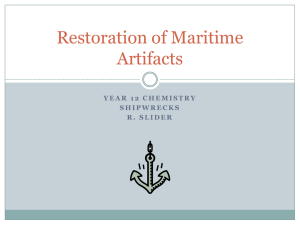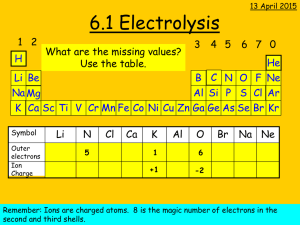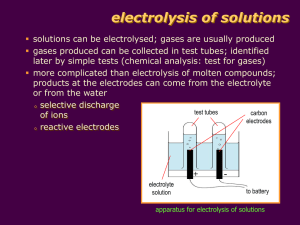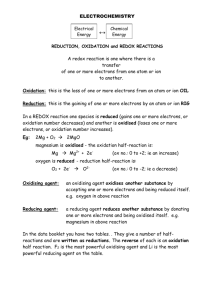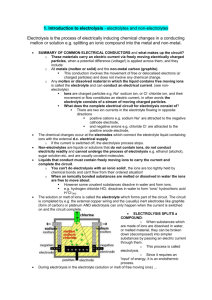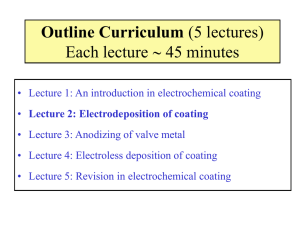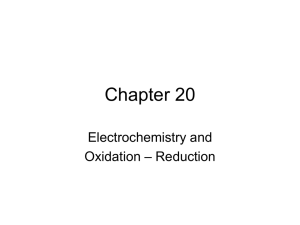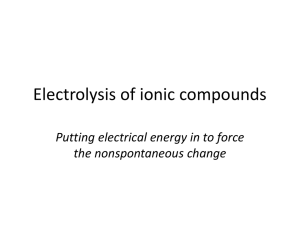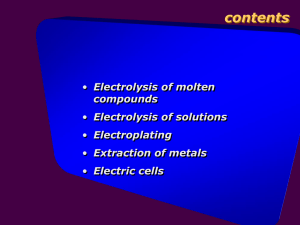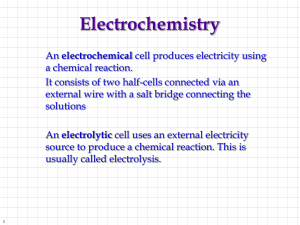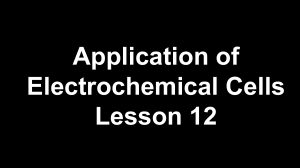Ch27(electrolysis) w..
advertisement
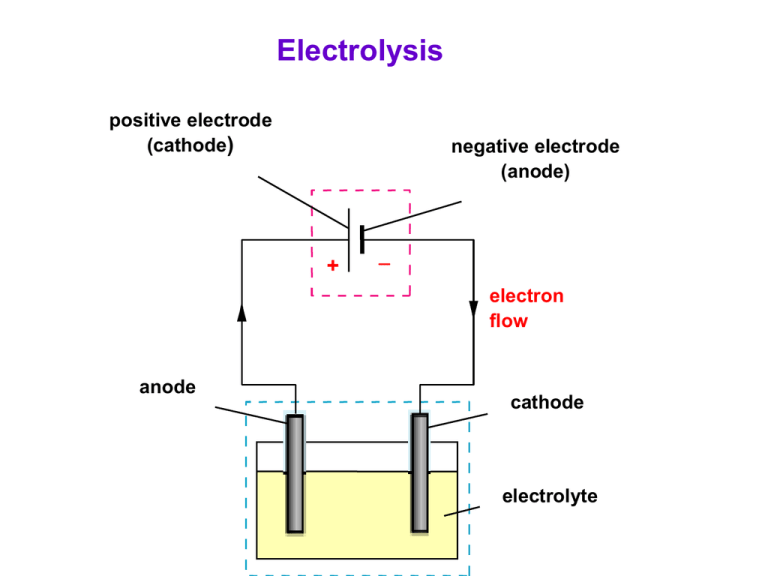
Electrolysis positive electrode (cathode) negative electrode (anode) + electron flow anode cathode electrolyte What is electrolysis? • By using electricity to decompose chemical substances in which a redox reaction is forced to take place What is cathode and anode? • Red cat, An ox What is positive and negative pole? • According to the battery A. Electrolysis of molten substance by using inert electrode • No preference of discharge of ions • + pole attracts negative ions, vice versa 2Br-(l) Br2(g) +2e- Pb2+(l) + 2e- Pb(l) B. Electrolysis of dilute solution by using inert electrode 4OH-(aq) O2(g) + 2H2O(l)+ 4e- rubber bands wooden piece electrolysis cell 2H+(aq) + 2e- H2(g) graphite electrodes Na+ Cl- H+ OH- very dilute sodium chloride solution partition e– e– – + 6V B. Electrolysis of dilute solution by using inert electrode • Preference of discharge of ions (according to the E.C.S) • negative ions go to anode and discharge in the order: OH->I->Br->Cl- >>>>SO42-, NO3• e.g. OH- ions discharge , as it is more readily to give electrons than other negative ions • positive ions go to anode and discharge in the order : Ag+>Cu2+>H+ >>>>other metal ions • e.g. H+ ions discharge, as it is more readily to accept electrons.( Cu2+/Ag+ discharges if they are present) C. Electrolysis of conc solution by using inert electrode 2H+(aq) + 2e- H2(g) - 2Cl (aq) Cl2(g) + 2e- C. Electrolysis of conc solution by using inert electrode • By concentration effect, the ions to be discharge may be different from the dilution solution. • e.g. negative ions discharge according to the order of ease to lose e-(s): OH->I->Br->Cl• although OH- is more readily to give electrons, however due to concentration effect (I-/Br-/Cl- are present in larger amount), I-/Br-/Cl- are discharged instead. • e.g. positive ions discharge according to the order of ease to gain e-(s): : Ag+>Cu2+>H+ >>>>other metal ions • The ion discharge is same as in dilute solution unless Mercury is used as anode. D. Electrolysis of dilute solution by using non-inert electrode Cu2+(aq) + 2e- Cu(s) Cu(s) Cu2+(aq) + 2e- Cu2+ OH- H+ SO4- The solution finally becomes…… D. Electrolysis of dilute solution by using non-inert electrode • Metals ALWAYS give electrons more readily than OH- ion. • + pole: metal electrode discharges, and dissolves, but not OH- ion. • Would the preference of discharge of ions be affected at the – pole by using non-inert electrode? • NO (metal solids always give electrons) e.g.1 Electrolysis of dil Zn(NO3)2 2H+ +2e- H2 Zn Pt Zn Zn2++2e- H+ OH- Zn2+ NO3- dil Zn(NO3)2 e.g.2 Electrolysis of conc sodium chloride using mercury as cathode plastic-covered wire ? water - + graphite (as anode) Clconcentrated sodium chloride solution (electrolyte) bare platinum wire Na+ H+ OH- mercury (as cathode) Reason: 1) Mercury prefers to form alloy with the metal formed. 2) conc effect At the cathode (mercury) Na+(aq) + e- Na(s) Reduction Na(s) + Hg(l) Na/Hg(l) sodium amalgam (alloy) Overall reaction at cathode: 2Na/Hg(l) + 2H2O(l) 2NaOH(aq) +H2(g) + 2Hg(l) At the anode (graphite) Oxidation Due to concentration effect, - 2Cl (aq) Cl2(g) + 2e- Overall reaction: 2Hg(l) + 2Na+(aq) + 2Cl (aq) 2Na/Hg(l) + Cl2(g) The sodium chloride solution becomes more and more dilute. Chemical cell Electrolytic cell A device for A device for bringing about Function generating electricity chemical changes by chemical changes by electricity A spontaneous redox A redox reaction is Type of reaction involved reaction takes place forced to take place Polarity of cathode + (reduction) - (reduction) electrode (and anode + (oxidation) - (oxidation) change) FACTORS AFFECTING THE RATE OF ELECTROLYSIS Increase the current Speed up electrolysis Uses of electrolysis A. Extraction of some reactive metals Molten chlorides of metals electrolysis Molten oxide of aluminium electrolysis Metals high in the E.C.S Aluminiu m e.g. Extraction of Aluminium 2O2- O2 + 4e- O2- O2- O2- O2- O2- O2- O2- O2- Al3+ Al3+ Al3+ Al3+ Al3+ Al3+ Al3+ +3e- Al B. Purification of metals e.g. Purify copper metal - Cu(s) Cu2+(aq) + 2e- + Cu2+(aq) + 2e- Cu(s) Cu2+ OHH+ SO42- What material is – electrode made up of? What is the assumption? C. Electroplating e.g Electroplating of nickel - Ni(s) Ni2+(aq) + 2e- + Ni2+(aq) + 2e- Ni(s) Ni2+ OH- H+ SO42- Can a plastic object be electroplated? Ag(s) Ag+(aq) + eA + – iron spoon (as cathode) silver anode plating bath (b) silver nitrate solution (a) Criterions: + Ag (aq) + e- Ag(s) Figure 27.18 (a) A set-up for electroplating silver on a spoon. (b) Electroplating silver on metal cups. Can we use this method to plate zinc on a coin? This setting only suits for silver, copper, nickel plating. 1) Objects to be plated always place at - pole 2) The electrolyte should contain the plated metal ions. D. Production of Cl2(g), H2(g), NaOH(aq) by electrolysis of conc. brine plastic-covered wire - + water OHNa+ bare platinum wire mercury (as cathode) H+ graphite (as anode) concentrated sodium chloride solution (electrolyte) Cl- At the cathode (mercury) Na+(aq) + e- Na(s) Na(s) + Hg(l) Na/Hg(l) sodium amalgam (alloy) Overall reaction at cathode: 2Na/Hg(l) + 2H2O(l) 2NaOH(aq) +H2(g) + 2Hg(l) At the anode (graphite) Due to concentration effect, - 2Cl (aq) Cl2(g) + 2e- USEFUL CHEMICALS E. Anodizing aluminium The resistance to corrosion of aluminium can be enhanced by anodizing it using electrolysis. A thicker protective layer of aluminum oxide is formed on the surface. + 2H+(aq) + 2e- H2 4OH- O2 + 2H2O + 4e- ? What are the advantages of anodization of aluminium?? WATER POLLUTION PROBLEMS IN HONG KONG WATER POLLUTION PROBLEMS ASSOCIATED WITH INDUSTRIAL EFFLUENTS Liquid wastes of electroplating 27.10 Acids Toxic chemicals Organic solvents Alkalis Metal salts Plating sludge Water pollution problems in Hong Kong (a) Industrial effluents (b) Polluted water stream becomes coloured. Figure 27.24 Water pollution due to industrial effluents. (c) Polluted water stream flows into the sea (d) Dark blue water stain in harbour. Figure 27.24 Water pollution due to industrial effluents. 1)acids and alkalis e.g. H2SO4 [remove oxides]; NaOH [removes oil] kill water plants and animals increase rusting rate of metal pipes and ships 2)heavy metal ions e.g. Cu2+ , Ni2+, Cr(VI), Pb2+ toxic to water plants and animals 3)cyanide (CN -) very toxic 1) Reducing the volume of waste solution (e.g. use less water for rinsing the object) 2) Recycling of the waste electrolyte. 3) Removal of toxic substances before disposing Common methods are : a) Adding Na2CO3 to remove the acids. e.g. Na2CO3 + H2SO4 Na2SO4 + CO2 + H2O b) Adding NaOH to precipitate the metal ions. e.g. 2NaOH(aq) + NiSO4(aq) Na2SO4(aq) + Ni(OH)2(s) 4) Reduce very toxic Cr(VI) compounds into less toxic Cr(III) ions. CONTROL OF CHEMICAL WASTE DISPOSAL IN HONG KONG Chemical waste producers such as electroplating factories are required to register with the Environmental Protection Department (EPD) for proper treatment and disposal of chemical wastes. Figure 27.26 The Chemical Waste Treatment Centre (CWTC) at Tsing Yi Island of Hong Kong. The Centre, having operated since May 1993, is capable of treating a great variety of chemical wastes.
